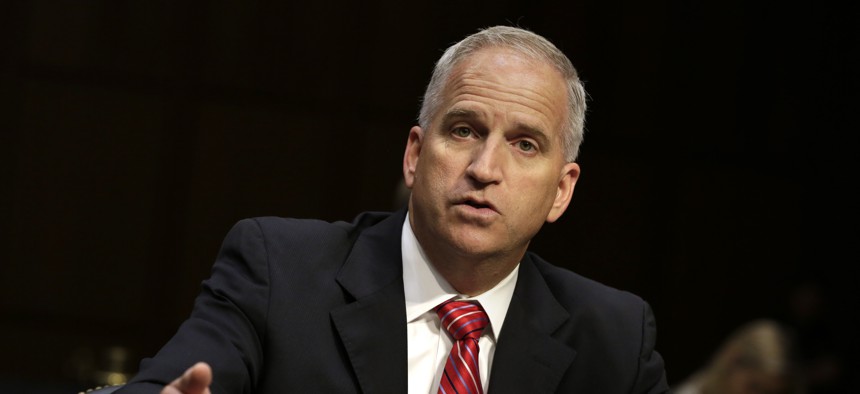
Robert Cardillo, director of the National Geospatial-Intelligence Agency, testifies before a Senate Select Committee on Intelligence on Capitol Hill in Washington, DC on September 27, 2016. AFP / YURI GRIPAS (Photo credit should read YURI GRIPAS/AFP via Getty Images)
Former NGA Head to Join Satellite-Imagery Firm
An intelligence chief who embraced transparency says AI will shape the next chapter of imagery analysis.
Planet, the company that uses small, low-Earth-orbit satellites to take daily pictures of the entire globe, has hired Robert Cardillo, the former head of the National Geospatial-Intelligence Agency, or NGA, to head its federal sales subsidiary.
As head of NGA, Cardillo embraced how open-source intelligence and publicly available imagery would reshape how intelligence agencies did their jobs, including how they interacted with the public. At Planet, he said in an exclusive interview, he’ll be joining a company whose imagery helps the public understand geopolitical events despite attempts by Russia and others to spread misinformation.
“Sunlight is said to be the best of disinfectants,” Cardillo said. “There’s lots of data, sources, and noise out there…but there are also actors feeding that confusion.”
“What I love about the time we’re moving into is that with companies like Planet we’re able to at least reground and rebaseline what has become a shaky framework in our discourse,” he said, adding that not everyone will agree on the meaning of what satellite images show. “But if we can elevate the conversation a bit…we can have a meaningful discussion.”
Cardillo will join Planet Federal — a subsidiary that sells to government clients — as chief strategist and chairman of the board. He served as the director of NGA from 2014 to 2019, right about the time that images from Planet satellites began to have an outsized impact on intelligence gathering and the public’s understanding of global events, thanks to social media. Cardillo said that when he began work as an intelligence analyst in 1983, the government had a monopoly on images from space. “Things have changed in the last 38 years,” he said. “What hasn’t changed is the mission.”
Robbie Schingler, Planet’s co-founder and chief strategy officer, further highlighted the importance of more open-source data reaching the public. He said that making the sorts of pictures that were once only available to governments instead available to the press and “strengthening the fourth estate around facts about the planet allows for more aspects of society to anticipate what’s going to happen.”
Emerging technologies like artificial intelligence already play a big role in the way Planet operates, said Schingler, “from tasking our satellite to downlinking it to some of the internal tools we use to manufacture and upgrade our satellites.”
But the biggest boon for Planet’s customers and consumers, he said, will be how AI enables Planet to better understand what their images mean in the context of other, open-source data. “You can come up with higher-order data products that are more specialized, to push to you, into your sense-making applications.” That will make the images more useful for everyone.
At NGA, Cardillo embraced how AI might help analysts much more quickly work through exploding volumes of satellite image data. That trend will continue, he said, and will also continue to change what analysts do, much as the sudden abundance of open-source imagery has changed the role of analysts over the past decade. “Some of my teammates saw AI as a threat…and I get it,” he said. “We want them on the really hard things like ‘What does that mean?’ And oh, ‘What’s going to happen tomorrow?’... It’s an exciting development because we’re going to do better answering” those types of questions.
If you follow geopolitical events, you’ve probably seen Planet’s images attached to a news story or broadcast. The company provides daily pictures of virtually the entire planet from their constellation of 150 small cube satellites. Schingler estimates that the company collects some two million new images, some 15 terabytes of raw data, each day. The images, which Planet often shares with members of the press, regularly shape coverage of major geopolitical events and hotspots, including North Korea, Russia, China, the Middle East, etc.
NEXT STORY: A Better Way to Spot Deep-Faked Satellite Images




